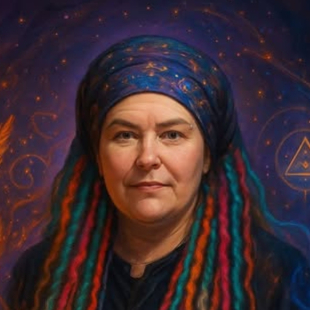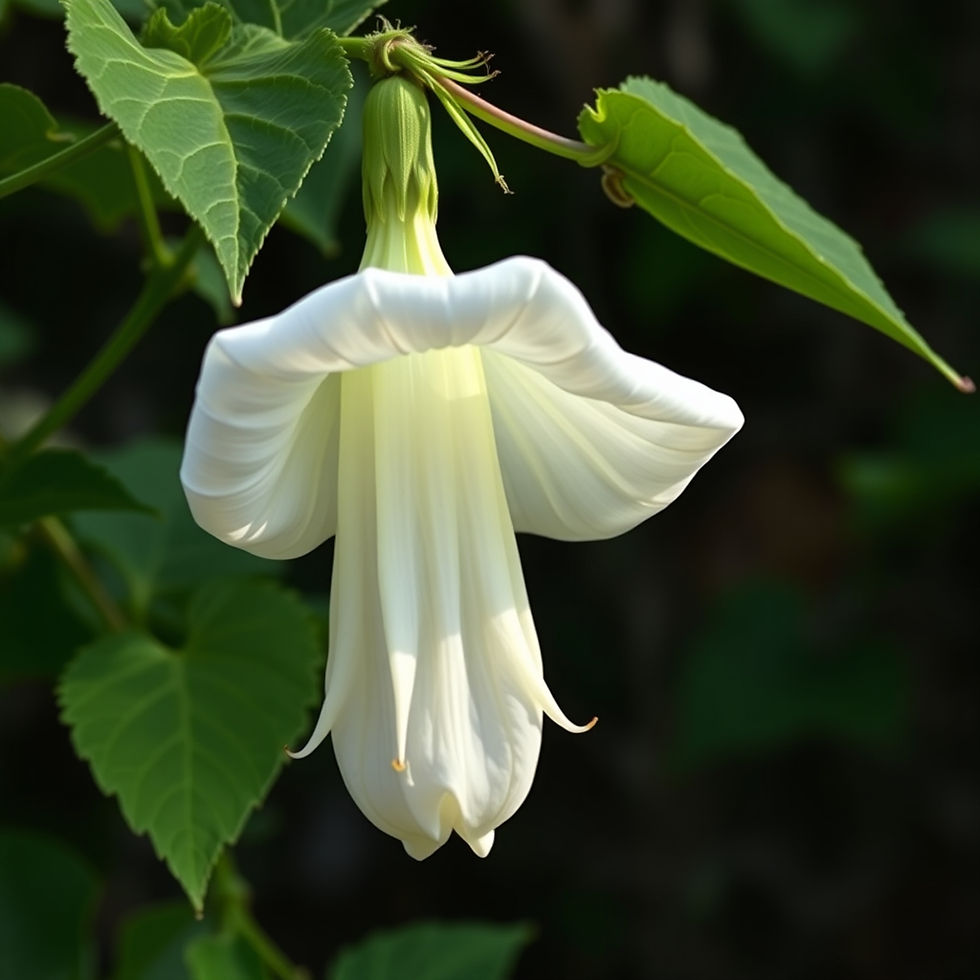🌸 Collapse is Not Failure: What the Moonflower Taught Me About Endings
- Gin

- Sep 13
- 4 min read
There are rules for moonflowers. Or so I thought.
A moonflower blooms in the evening, its petals spiraling open like a chalice of moonlight, glowing white in the dark. By morning, the bloom closes, its purpose complete. That’s the contract. That’s the law of their being.

But contracts are meant to be broken when Spirit wants to teach.
This summer, under the shadow of a Black Moon, one of my moonflowers refused to obey the rules. She opened wide one night, filled the air with a perfume that smelled almost childlike—like Fruit Loops and honey—and when dawn came, she stayed. Wide open. Refusing closure. And when night fell again, she bloomed a second time.
The Two-Night Bloom.
I stood in awe. This was no accident. Nature had broken its own contract to mirror something in me: vows of scarcity and silence, vows of invisibility and Atlas-like burden, all breaking under the same Black Moon.
And then, something happened that unraveled me.
On the second morning, I reached out. Just a fingertip on her soft white petals. Not to harm. To comfort. To say, “Don’t close yet. Please, stay open.”
Fifteen minutes later, when I returned from walking my dog Bear, I found her collapsed. Not in the elegant pleating I’d seen before, where the bloom folds into itself like a ballerina curtseying. This was different. Her petals hung limp, heavy, like pizza dough sliding off the counter. The stem bowed under the weight of exhaustion.
And my heart sank. I felt guilt, as if my touch had broken her. I felt grief, as if beauty had been wasted. I felt shame, as if I had failed her somehow.
But the story wasn’t finished.
That night, I checked again—and gasped. She had risen. The bloom was upright, pleating itself closed with resolve, stem firm again. She had resurrected herself.
And by the next morning, the sun touched her, and she took her final bow. Upright, sealed, dignified.
One bloom. Three endings. Collapse. Resurrection. Bow.
And in that cycle, the moonflower taught me the truth about endings that every human needs to know.
Lesson One: Collapse Is Not Failure
When the bloom collapsed, I felt shame. We live in a culture that despises collapse. We prize resilience, performance, endless bloom. We don’t know what to do with tiredness, fragility, surrender.
But psychology tells another story. Trauma therapists describe something called pendulation—the nervous system’s natural swing between overwhelm and regulation. Collapse is part of the cycle. When we push too long, hold too much, our systems flop. Not as failure, but as reset.
The moonflower wasn’t broken. She was overwhelmed. She was softening under the weight of being held open too long—just as we do when we refuse to let go of jobs, relationships, identities that want to end.
Collapse is the body’s honest way of saying: Enough.
It isn’t failure. It’s physiology. It’s sacred.
Lesson Two: Resurrection Is Always Possible
At midnight, she rose again. And that’s the other half of the nervous system’s wisdom. After collapse, the body regathers. Breath deepens. Spine straightens. The bloom remembered her form.
We call it resilience, but maybe that word is too shiny, too heroic. The moonflower didn’t “fight back.” She simply reorganized. Nature does this all the time. Forests regrow after fire. Rivers carve new paths after flood. Our hearts do, too, if we let them.
Resurrection isn’t rare. It’s built into the fabric of life.
The moonflower whispered: Don’t fear collapse, Gin. Resurrection is already written into your cells.
Lesson Three: The Bow Is Sacred
When the sun touched her the final morning, she bowed. Upright, pleated, sealed. A dignified close.
And that, beloveds, is what most of us long for: not endless performance, not collapse without meaning, but a dignified ending.
The bow is the moment closure becomes blessing. It tells the story: I am complete. I have offered what I came to offer. I bless what comes next.
The bow makes space for new life. Without the bow, we cling, and nothing else can grow.
The moonflower taught me that dignity is not in holding on. It is in letting go with grace.

The Dharma of Endings
So here is the Dharma she offered me:
Collapse, resurrection, bow. These are not failures, but stages.
Atlas reflex—that vow to hold everything together forever—must be broken. We don’t need to hold blooms open past their time.
Celebration is not dependent on witnesses. I stood alone on my deck with that flower, but I was the celebration. Not because anyone saw, but because I was present.
We think beauty is only beauty when it’s Instagram-worthy, witnessed by many. But the moonflower says: You are the witness. That is enough.
Integration for Your Life
If you are in collapse right now, hear this: you are not failing. You are resetting.
If you are in resurrection, hear this: breathe, take your time. Form is returning. Trust it.
If you are bowing, hear this: close with dignity. Bless what comes next.
Try this simple ritual:
Name what is ending. Write it down.
Allow the flop. Speak honestly about what feels messy, tired, undone.
Invite the rise. Take three deep breaths. Feel your spine lengthen.
Seal the bow. Place a hand on your heart and whisper: “I close with dignity.”
Taste sweetness. Eat something sweet. Anchor joy in your ending.
Closing
The moonflower carried me through vow-breaking under the Black Moon. She collapsed when I clung. She rose when night reorganized her. She bowed when dawn blessed her.
And in her, I saw myself.
Collapse is not failure. Resurrection is inevitable. The bow is sacred.
So flop without shame. Rise without apology. Bow with grace.
Because you, beloved, are the celebration.




Comments